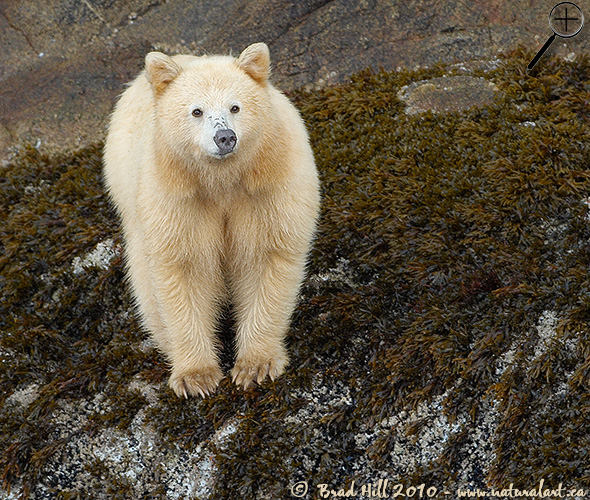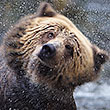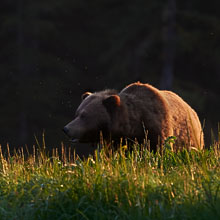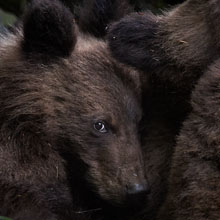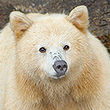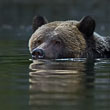In the Field
Spirit Bear in Intertidal Zone. Great Bear Rainforest (northern BC coast), Canada. October 11, 2007.
There's a few islands on the northern coast of British Columbia where the very rare white-phased "Spirit" (or Kermode) bears aren't too rare. The coat colour is controlled by the genetic makeup of the particular bears - to be white a bear must possess two recessive copies of a particular gene. Why these bears are relatively common in this small geographic area is unknown - presumably the white coats either give the bear some unknown advantage or, at the very least, the negatives associated with the coat colour (such as its "anti-camouflage" or "stick-out-like-a-sore-thumb" properties) aren't important in this particular environment! Certainly, this bear wasn't too hard to spot on this section of the intertidal zone!
There was really only one photographic challenge to overcome in capturing this image - holding my camera steady enough to capture the image. I shot this image from a moving Zodiac inflatable boat that was rocking in the waves (it was darned tough just to keep the bear in the viewfinder). Without some form of Vibration Reduction (or Image Stabilization) technology it likely would have been impossible to capture this image.
NOTE: This image was captured in a region of British Columbia known as "The Great Bear Rainforest". I offer both instructional photo tours and "photo op only" photo tours into the Great Bear Rainforest each spring and autumn. If you're interested in more information about one of these tours, details are available on the Photo Tours page of this website!
Behind the Camera
Spirit Bear in Intertidal Zone. Great Bear Rainforest (northern BC coast), Canada. October 11, 2007.
Digital Capture; Uncompressed RAW (NEF) format; ISO 250.
Nikon D2X with Nikon 200-400 mm f/4G ED-IF AF-S VR lens @ 340 mm (510 mm equivalent with digital conversion factor) "balanced" on pontoon of moving Zodiac inflatable boat. VR turned to "On" and in "Active" mode. AquaTech SportShield (rain cover) used to protect camera and lens.
1/320s @ f4; -0.33 stop compensation from matrix-metered exposure setting.
At the Computer
Spirit Bear in Intertidal Zone. Great Bear Rainforest (northern BC coast), Canada. October 11, 2007.
RAW Conversion to 16 bit TIFF, including first-pass sharpening and exposure compensation using Phase One's C1 Pro.
Further digital correction on 16-bit TIFF file using Adobe's Photoshop CS3 and LightZone 3. Minor tonal adjustments performed in LightZone (using the ToneMapper/Relight tool). Photoshop adjustments included selective saturation enhancement, selective curves adjustment, and selective sharpening for web output.
Conservation
Spirit Bear in Intertidal Zone. Great Bear Rainforest (northern BC coast), Canada. October 11, 2007.
Ten percent of the revenue generated by this image will be donated to Raincoast.
The "Spirit" or "Kermode" Bear is a rare genetically-based colour variant of the common Black Bear (Ursus americana). It has been estimated that less than 200 Spirit Bears exist today. Because the Black Bear is not considered under threat as a species, the Spirit Bear suffers from having the same conservation designation (it should be acknowledged that in British Columbia - the jurisdiction of greatest Spirit Bear abundance - hunting of these white-coated bears is not permitted). For reasons that are not fully understood, the Spirit Bear occurs with greater frequency in a relatively small geographic area within The Great Bear Rainforest of the central and northern coast of British Columbia. In this area 10 to 30% of the bears possess white coats. Unfortunately, this globally unique habitat is under development pressure, especially from the forestry industry. If this unique environment is altered, we may lose the wonderful genetic anomaly known as the Spirit Bear.
The Raincoast Conservation Society (and Foundation) is an effective and efficient organization that has been fighting for protection of this unique habitat. If you are looking for a meaningful way to contribute to the conservation of this amazing ecosystem, Raincoast will provide maximal "bang" for your conservation dollars.












